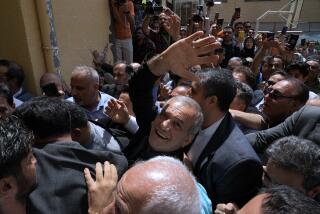Iran’s anti-government protestors clash with security forces
- Share via
BEIRUT AND TEHRAN — A cry from the streets of Tehran put Iranian attitudes toward America at the center of a day of violent clashes Wednesday.
“Obama, Obama!” protesters chanted on a day marking the 30th anniversary of the United States Embassy takeover. “Either you’re with them, or with us.”
The poignant slogan came in contrast to that of nearby government supporters and schoolchildren draped in Iranian flags, who chanted, “Death to America!” reiterating the rallying cry of the Islamic Revolution, which toppled U.S.-backed Shah Mohammed Reza Pahlavi, establishing Iran as the world’s first modern theocracy.
Radical students stormed the U.S. Embassy in Tehran on Nov. 4, 1979, holding American personnel hostage for 444 days in a move that severed official ties between Tehran and Washington and ushered in an era of deep hostility between the two countries.
The day is traditionally used by the Iranian government to whip up anti-American furor. State television showed thousands of Iranians, mostly schoolchildren, carrying placards and chanting near the site of the former embassy.
“The Americans are scared of religious democracy in our country more than anything else,” lawmaker Gholam Ali Haddad Adel said at the official rally. “This is because Iran’s religious democracy could turn into a role model in other countries.”
But protesters who claim that the June 12 reelection of President Mahmoud Ahmadinejad was fraudulent subverted the event, battling security forces into the night and turning large stretches of the Iranian capital into scenes of chaos and violence.
Amateur video posted on the Internet suggested that the unrest unleashed by the disputed election was spreading throughout the country. Small, boisterous demonstrations broke out Wednesday in the agricultural hub of Qazvin, the Caspian Sea port city of Rasht, the oil-rich southwestern city of Ahvaz, the northeastern holy city of Mashhad and the central Iranian cities of Esfahan, Shiraz and Najafabad.
And for the first time in months, there were credible reports and video of a sizable demonstration on the campus of the main university in the northwestern city of Tabriz, the commercial capital of Iran’s ethnic Azeri region and historically a hotbed of political activity.
Though not as large as demonstrations that erupted immediately after the disputed June election, Wednesday’s protests struck at one of the ideological pillars of the Islamic Republic by showing that a sizable chunk of the population disagrees with hard-liners’ anti-American agenda.
As Ahmadinejad’s allies assailed U.S. foreign policy during the official rally, a leading reformist cleric and architect of the Islamic Revolution issued a provocative statement describing the long-ago storming of the U.S. mission in Tehran as a mistake.
“Considering the negative repercussions and the high sensitivity which was created among the American people and which still exists, it was not the right thing to do,” Ayatollah Hossein Ali Montazeri said in a statement on his website.
But some Iranian opposition supporters fear that the Obama administration’s concern with resolving the crisis over Tehran’s nuclear ambitions might cause it to undermine the protest movement’s aspirations.
“The U.S. dialogue with Iran over the nuclear issue implies recognition and legitimacy of the Ahmadinejad government,” said Nader Hashemi, an Iran expert at the University of Denver. “Many Iranians are deeply upset by this given the stolen election and the recent political repression. They want Obama to speak out more forcefully in support of their democratic ideals.”
President Obama issued a statement Tuesday night urging Iran’s leaders to join with him in overcoming the acrimony forged by the hostage crisis three decades ago.
“This event helped set the United States and Iran on a path of sustained suspicion, mistrust and confrontation,” Obama said. “I have made it clear that the United States of America wants to move beyond this past, and seeks a relationship with the Islamic Republic of Iran based upon mutual interests and mutual respect.”
A White House spokesman said the U.S. was monitoring the situation in Iran.
Throughout the day Wednesday, video, photographs and witness accounts surfaced of violent confrontations across the capital between paramilitary forces controlled by the hard-line Revolutionary Guard and unarmed demonstrators. Reformist websites reported the arrests of numerous protesters.
Security forces fired tear gas and rubber bullets and attempted to surround demonstrators to prevent them from forming large gatherings. There were reports of shots fired into the air.
“I was beaten up with a baton so badly that one policeman begged his colleague to have pity on me and stop beating me,” said a 54-year-old mother of three who asked that her name not be published. “But I am not scared. I will keep protesting until the end.”
By and large, security personnel used nonlethal force, reluctant to hand the opposition more reasons for rallying cries in a Shiite Muslim culture that elevates victims of political violence to martyrdom.
Video showed black-clad riot policemen accompanied by plainclothes Basiji militiamen beating protesters with clubs and storming into apartment buildings where they had sought refuge.
One witness said he even saw soldiers collapsing from tear gas fired at demonstrators, who tried to ward off the effects of the gas by setting trash fires.
The crowd cheered as opposition presidential candidate Mehdi Karroubi arrived at 7th of Tir Square to attend an opposition rally. Reformist websites said a phalanx of 250 security personnel prevented another presidential candidate, opposition leader Mir-Hossein Mousavi, from leaving his neighborhood to join in the protest.
--
Mostaghim is a special correspondent.
More to Read
Sign up for Essential California
The most important California stories and recommendations in your inbox every morning.
You may occasionally receive promotional content from the Los Angeles Times.










